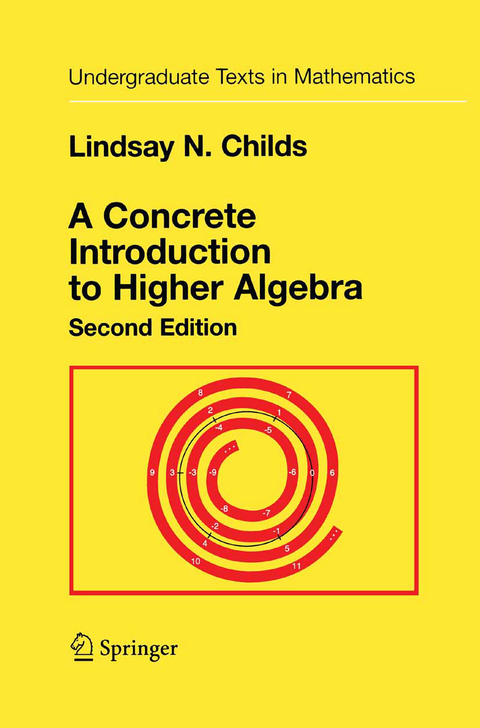
A Concrete Introduction to Higher Algebra
Springer-Verlag New York Inc.
978-0-387-98999-0 (ISBN)
This book is written as an introduction to higher algebra for students with a background of a year of calculus. The first edition of this book emerged from a set of notes written in the 1970sfor a sophomore-junior level course at the University at Albany entitled "Classical Algebra." The objective of the course, and the book, is to give students enough experience in the algebraic theory of the integers and polynomials to appre ciate the basic concepts of abstract algebra. The main theoretical thread is to develop algebraic properties of the ring of integers: unique factorization into primes, congruences and congruence classes, Fermat's theorem, the Chinese remainder theorem; and then again for the ring of polynomials. Doing so leads to the study of simple field extensions, and, in particular, to an exposition of finite fields. Elementary properties of rings, fields, groups, and homomorphisms of these objects are introduced and used as needed in the development. Concurrently with the theoretical development, the book presents a broad variety of applications, to cryptography, error-correcting codes, Latin squares, tournaments, techniques of integration, and especially to elemen tary and computational number theory. A student who asks, "Why am I learning this?," willfind answers usually within a chapter or two. For a first course in algebra, the book offers a couple of advantages. • By building the algebra out of numbers and polynomials, the book takes maximal advantage of the student's prior experience in algebra and arithmetic. New concepts arise in a familiar context.
1 Numbers.- 2 Induction.- A. Induction.- B. Another Form of Induction.- C. Well-Ordering.- D. Division Theorem.- E. Bases.- F. Operations in Base a.- 3 Euclid’s Algorithm.- A. Greatest Common Divisors.- B. Euclid’s Algorithm.- C. Bezout’s Identity.- D. The Efficiency of Euclid’s Algorithm.- E. Euclid’s Algorithm and Incommensurability.- 4 Unique Factorization.- A. The Fundamental Theorem of Arithmetic.- B. Exponential Notation.- C. Primes.- D. Primes in an Interval.- 5 Congruences.- A. Congruence Modulo m.- B. Basic Properties.- C. Divisibility Tricks.- D. More Properties of Congruence.- E. Linear Congruences and Bezout’s Identity.- 6 Congruence Classes.- A. Congruence Classes (mod m): Examples.- B. Congruence Classes and ?/m?.- C. Arithmetic Modulo m.- D. Complete Sets of Representatives.- E. Units.- 7 Applications of Congruences.- A. Round Robin Tournaments.- B. Pseudorandom Numbers.- C. Factoring Large Numbers by Trial Division.- D. Sieves.- E. Factoring by the Pollard Rho Method.- F. Knapsack Cryptosystems.- 8 Rings and Fields.- A. Axioms.- B. ?/m?.- C. Homomorphisms.- 9 Fermat’s and Euler’s Theorems.- A. Orders of Elements.- B. Fermat’s Theorem.- C. Euler’s Theorem.- D. Finding High Powers Modulo m.- E. Groups of Units and Euler’s Theorem.- F. The Exponent of an Abelian Group.- 10 Applications of Fermat’s and Euler’s Theorems.- A. Fractions in Base a.- B. RSA Codes.- C. 2-Pseudoprimes.- D. Trial a-Pseudoprime Testing.- E. The Pollard p — 1 Algorithm.- 11 On Groups.- A. Subgroups.- B. Lagrange’s Theorem.- C. A Probabilistic Primality Test.- D. Homomorphisms.- E. Some Nonabelian Groups.- 12 The Chinese Remainder Theorem.- A. The Theorem.- B. Products of Rings and Euler’s ?-Function.- C. Square Roots of 1 Modulo m.- 13 Matricesand Codes.- A. Matrix Multiplication.- B. Linear Equations.- C. Determinants and Inverses.- D. Mn(R).- E. Error-Correcting Codes, I.- F. Hill Codes.- 14 Polynomials.- 15 Unique Factorization.- A. Division Theorem.- B. Primitive Roots.- C. Greatest Common Divisors.- D. Factorization into Irreducible Polynomials.- 16 The Fundamental Theorem of Algebra.- A. Rational Functions.- B. Partial Fractions.- C Irreducible Polynomials over ?.- D. The Complex Numbers.- E. Root Formulas.- F. The Fundamental Theorem.- G. Integrating.- 17 Derivatives.- A. The Derivative of a Polynomial.- B. Sturm’s Algorithm.- 18 Factoring in ?[x], I.- A. Gauss’s Lemma.- B. Finding Roots.- C. Testing for Irreducibility.- 19 The Binomial Theorem in Characteristic p.- A. The Binomial Theorem.- B. Fermat’s Theorem Revisited.- C. Multiple Roots.- 20 Congruences and the Chinese Remainder Theorem.- A. Congruences Modulo a Polynomial.- B. The Chinese Remainder Theorem.- 21 Applications of the Chinese Remainder Theorem.- A. The Method of Lagrange Interpolation.- B. Fast Polynomial Multiplication.- 22 Factoring in Fp[x] and in ?[x].- A. Berlekamp’s Algorithm.- B. Factoring in ?[x] by Factoring mod M.- C. Bounding the Coefficients of Factors of a Polynomial.- D. Factoring Modulo High Powers of Primes.- 23 Primitive Roots.- A. Primitive Roots Modulo m.- B. Polynomials Which Factor Modulo Every Prime.- 24 Cyclic Groups and Primitive Roots.- A. Cyclic Groups.- B. Primitive Roots Modulo pe.- 25 Pseudoprimes.- A. Lots of Carmichael Numbers.- B. Strong a-Pseudoprimes.- C. Rabin’s Theorem.- 26 Roots of Unity in ?/m?.- A. For Which a Is m an a-Pseudoprime?.- B. Square Roots of ?1 in ?/p?.- C. Roots of ?1 in ?/m?.- D. False Witnesses.- E. Proof of Rabin’s Theorem.- F. RSA Codes andCarmichael Numbers.- 27 Quadratic Residues.- A. Reduction to the Odd Prime Case.- B. The Legendre Symbol.- C. Proof of Quadratic Reciprocity.- D. Applications of Quadratic Reciprocity.- 28 Congruence Classes Modulo a Polynomial.- A. The Ring F[x]/m(x).- B. Representing Congruence Classes mod m(x).- C. Orders of Elements.- D. Inventing Roots of Polynomials.- E. Finding Polynomials with Given Roots.- 29 Some Applications of Finite Fields.- A. Latin Squares.- B. Error Correcting Codes.- C. Reed-Solomon Codes.- 30 Classifying Finite Fields.- A. More Homomorphisms.- B. On Berlekamp’s Algorithm.- C. Finite Fields Are Simple.- D. Factoring xpn — x in Fp[x].- E. Counting Irreducible Polynomials.- F. Finite Fields.- G. Most Polynomials in Z[x] Are Irreducible.- Hints to Selected Exercises.- References.
| Reihe/Serie | Undergraduate Texts in Mathematics |
|---|---|
| Zusatzinfo | XV, 522 p. |
| Verlagsort | New York, NY |
| Sprache | englisch |
| Maße | 155 x 235 mm |
| Themenwelt | Mathematik / Informatik ► Mathematik ► Algebra |
| ISBN-10 | 0-387-98999-4 / 0387989994 |
| ISBN-13 | 978-0-387-98999-0 / 9780387989990 |
| Zustand | Neuware |
| Haben Sie eine Frage zum Produkt? |
aus dem Bereich


